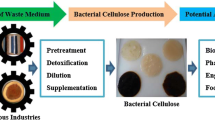Abstract
Paper mill sludge is a solid waste material generated from pulping and papermaking operations. Because of high glucan content and its well-dispersed structure, paper mill sludges are well suited for bioconversion into value-added products. It also has high ash content originated from inorganic additives used in papermaking, which causes hindrance to bioconversion. In this study, paper mill sludges from Kraft process were de-ashed by a centrifugal cleaner and successive treatment by sulfuric acid and sodium hydroxide, and used as a substrate for cellulase production. The treated sludge was the only carbon source for cellulase production, and predominantly inorganic nutrients were used as the nitrogen source for this bioprocess. The cellulase enzyme produced from the de-ashed sludge exhibited cellulase activity of 8 filter paper unit (FPU)/mL, close to that obtainable from pure cellulosic substrates. The yield of cellulase enzyme was 307 FPU/g glucan of de-ashed sludge. Specific activity was 8.0 FPU/mg protein. In activity tests conducted against the corn stover and α-cellulose, the xylanse activity was found to be higher than that of a commercial cellulase. Relatively high xylan content in the sludge appears to have induced high xylanase production. Simultaneous saccharification and fermentation (SSF) was performed using partially de-ashed sludge as the feedstock for ethanol production using Sacharomyces cerevisiae and the cellulase produced in-house from the sludge. With 6% (w/v) glucan feed, ethanol yield of 72% of theoretical maximum and 24.4 g/L ethanol concentration were achieved. These results were identical to those of the SSF using commercial cellulases.







Similar content being viewed by others
References
Ronneberg, D., & Naik, T. R. (2007). Available from: www1.eere.energy.gov/industry/forest/pdfs/res_solids_2007.pdf.
Duff, S. J. B., Moritz, J. W., & Anderson, K. L. (1994). Canadian Journal of Chemical Engineering, 72, 1013–1020.
Fan, Z. L., & Lynd, L. R. (2007). Bioprocess and Biosystems Engineering, 30, 27–34.
Fan, Z., & Lynd, L. R. (2006). Bioprocess and Biosystems Engineering, 30(1), 35–45.
Ruy, D., & Mandels, M. (1980). Enzyme and Microbial Technology, 2, 91–102.
Lynd, L. R. (1990). Applied Biochemistry and Biotechnology, 24/25, 695–719.
Chen, S., & Wayman, M. (1991). Process Biochemistry, 26, 93–100.
Shin, C. S., Lee, J. P., Lee, J. S., & Park, S. C. (2000). Applied Biochemistry and Biotechnology, 84/86, 237–245.
Juhasz, T., Szengyel, Z., Peczey, K., Aiika-Aho, M., & Viikari, L. (2005). Process Biochemistry, 40, 3519–3525.
Lo, C. M., Zhang, Q., Lee, P., & Ju, L. K. (2005). Applied Biochemistry and Biotechnology, 121/124, 561–573.
Bigelow, M., & Wyman, C. E. (2002). Applied Biochemistry and Biotechnology, 98/100, 921–934.
Maheshwari, D. K., Gohede, S., Paul, J., & Varma, A. (1994). Carbohydrate Polymers, 23, 161–163.
Miller, G. L. (1959). Analytical Chemistry, 31, 426–428.
NREL (2008). Laboratory Analytical Procedure (LAP), National Renewable Energy Laboratory,Golden,CO. Available from: www.nrel.gov/biomass/analytical_procedures.html.
Wood, T. M., & Bhat, K. M. (1988). Methods in Enzymology, 160, 87–112.
Bailey, M. J., Biely, P., & Poutanen, K. (1992). Journal of Biotechnology, 23, 257–270.
Hägerdal, B., Harris, H., & Pye, E. K. (1979). Biotechnology and Bioengineering, 21(3), 345–355.
Bradford, M. M. (1976). Analytical Biochemistry, 72, 248–254.
Velkovska, S., Marten, M. R., & Ollis, D. F. (1997). Journal of Biotechnology, 54, 83–94.
Domingues, F. C., Queiroz, J. A., Cabral, J. M. C., & Fonseca, L. P. (2000). Enzyme and Microbial Technology, 26, 394–401.
Gupta, R., Kim, T. H., & Lee, Y. Y. (2008). Applied Biochemistry and Biotechnology, 148(1–3), 59–70.
Acknowledgment
The authors wish to acknowledge the financial support provided by Masada Oxynol, LLC, Alabama Center for Pulp and Bioresource Engineering, Laboratory of Biofuels and Biomaterials, Auburn University. They are grateful to Boise Paper, Jackson, AL for providing paper mill sludges and associated technical information, and to Genencor-Danisco, Palo Alto, CA for providing cellulase enzymes.
Author information
Authors and Affiliations
Corresponding author
Rights and permissions
About this article
Cite this article
Wang, W., Kang, L. & Lee, Y.Y. Production of Cellulase from Kraft Paper Mill Sludge by Trichoderma Reesei Rut C-30. Appl Biochem Biotechnol 161, 382–394 (2010). https://doi.org/10.1007/s12010-009-8863-x
Received:
Accepted:
Published:
Issue Date:
DOI: https://doi.org/10.1007/s12010-009-8863-x




